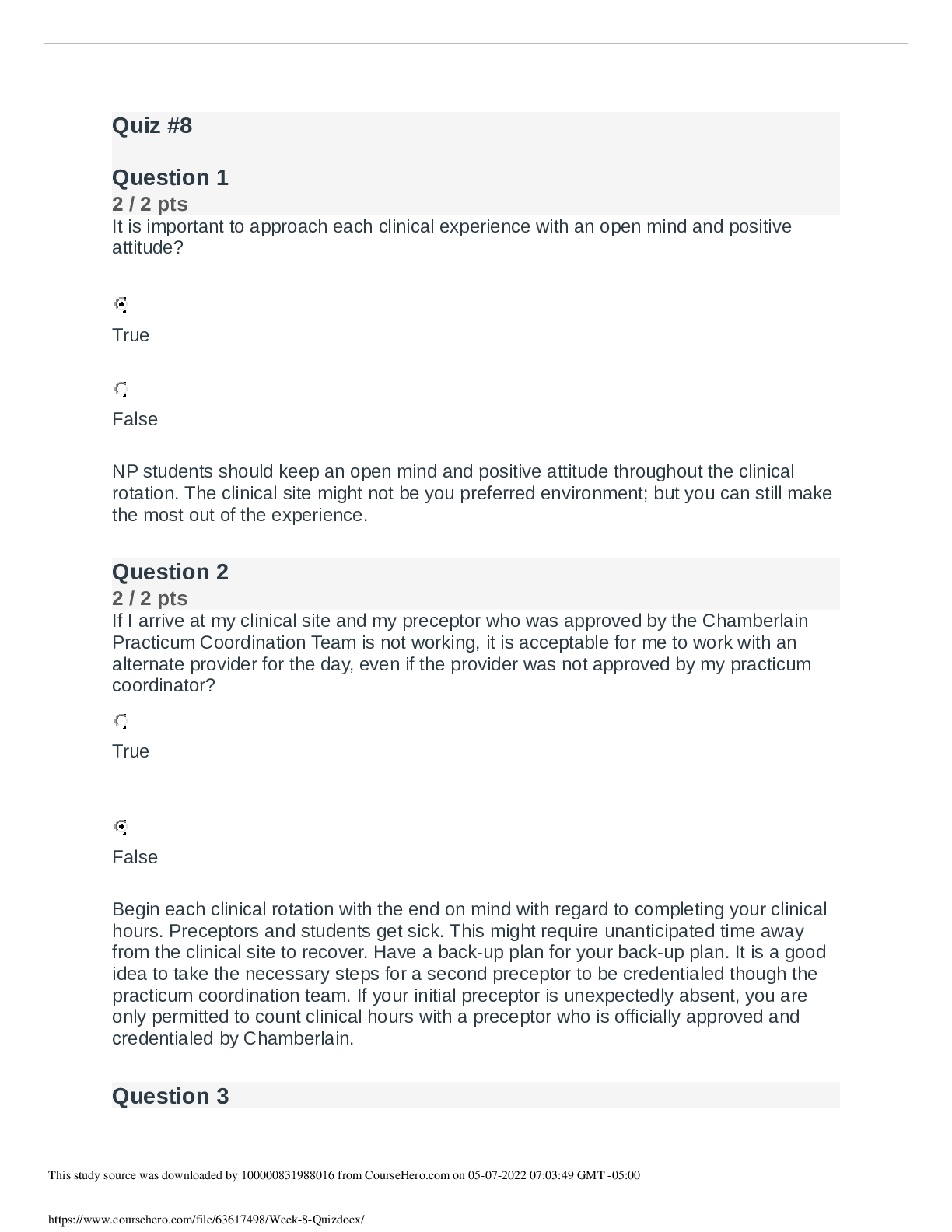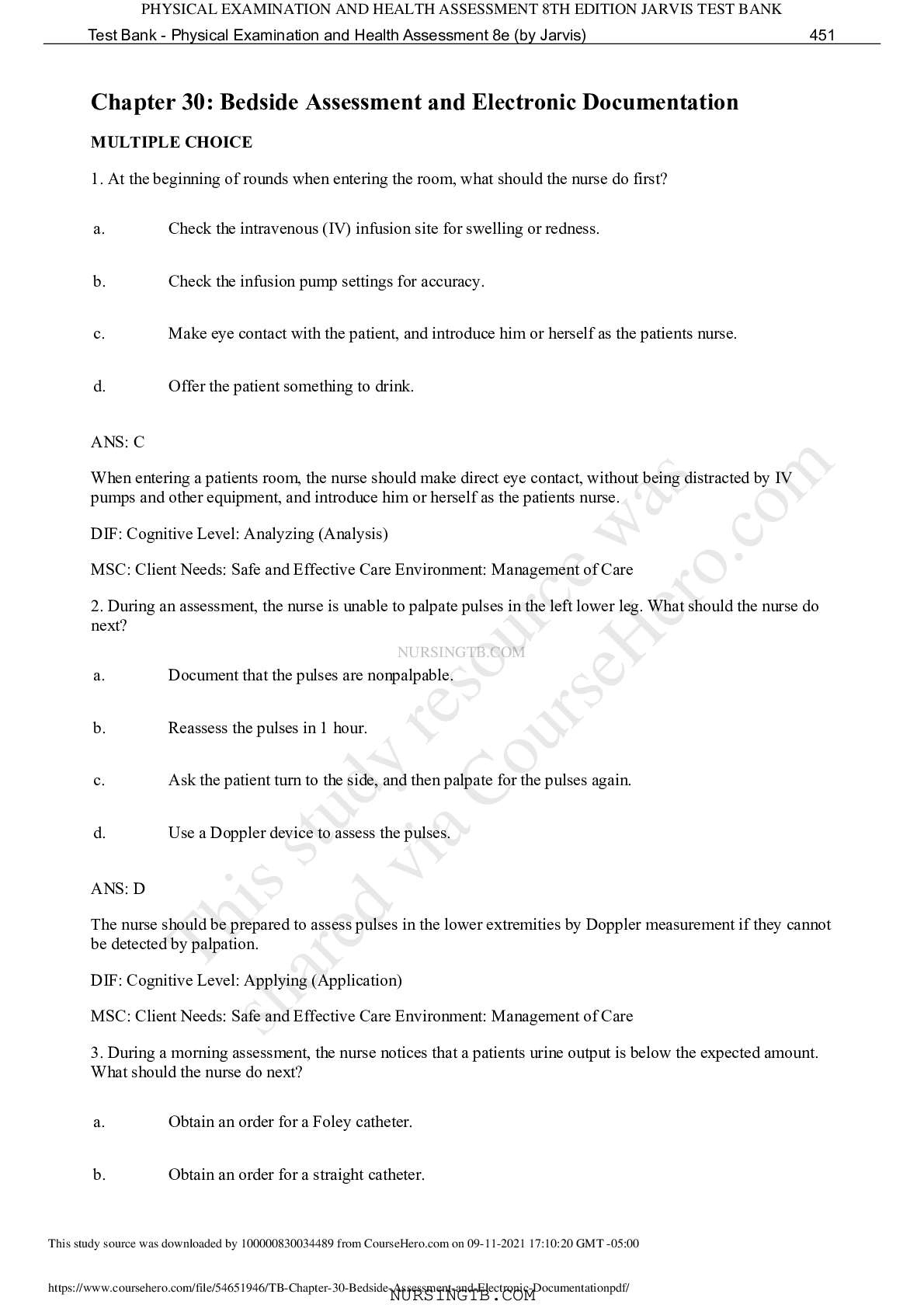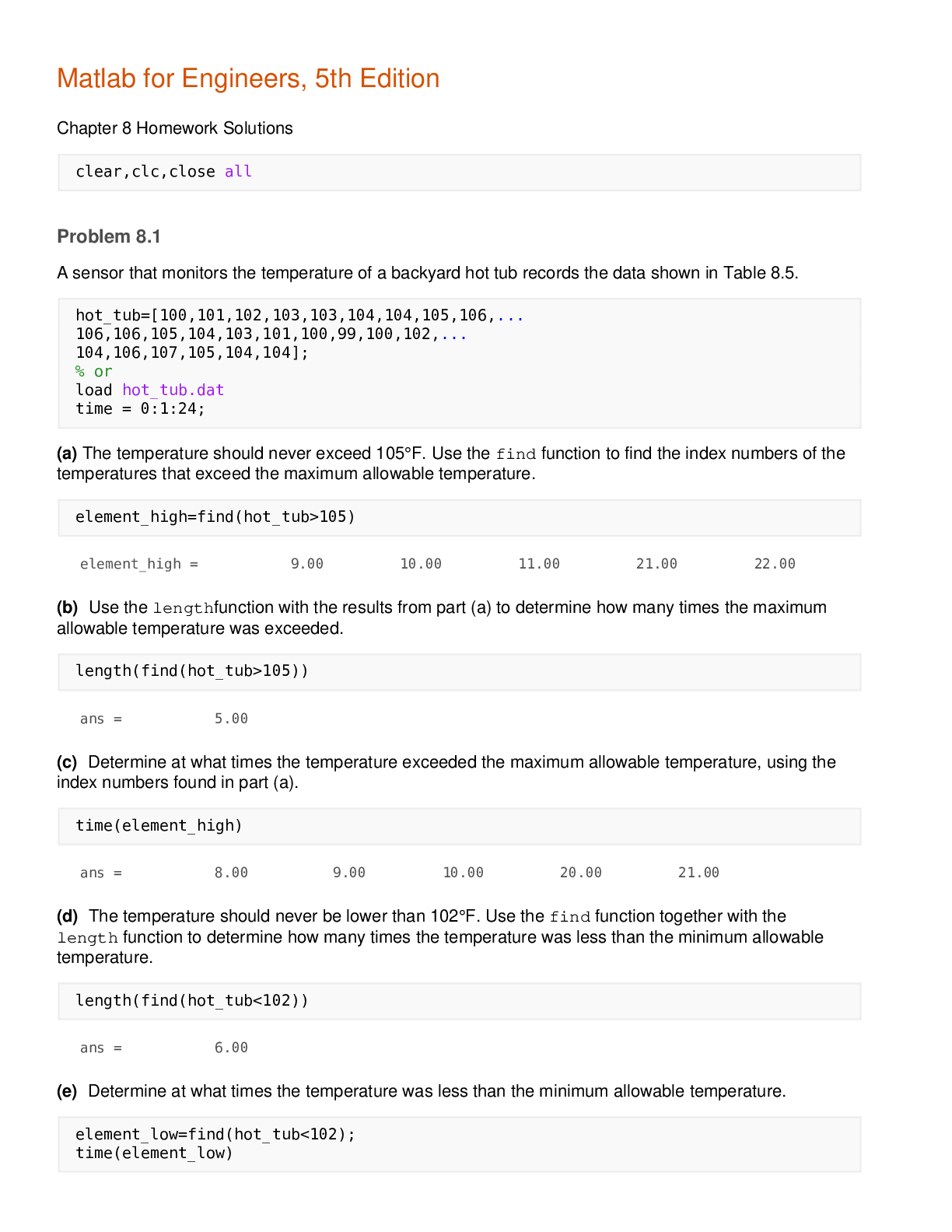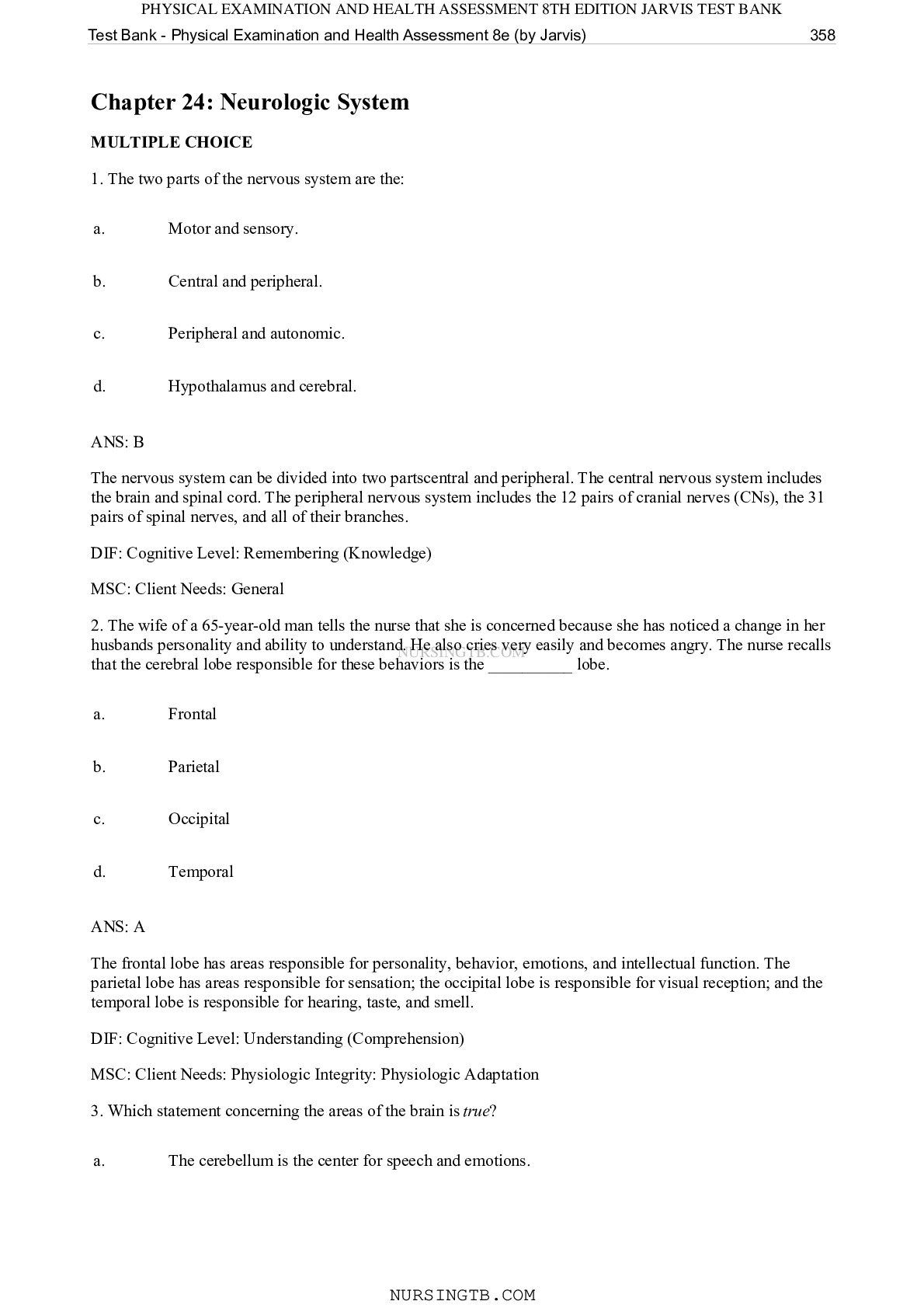*NURSING > QUESTIONS & ANSWERS > SOLVED!!! NR 509 COMPREHENSIVE REVIEW OF JARVIS 7TH EDITION CHAPTER 8 QUESTIONS (All)
SOLVED!!! NR 509 COMPREHENSIVE REVIEW OF JARVIS 7TH EDITION CHAPTER 8 QUESTIONS
Document Content and Description Below
SOLVED!!! NR 509 COMPREHENSIVE REVIEW OF JARVIS 7TH EDITION CHAPTER 8 QUESTIONS (Assessment Techniques and Safety in the Clinical Setting: Physical Examination & Health Assessment) ◇This material co... ntains comprehensive summary of information in the form of great test questions with descriptive answers helpful for exams study. Thorough Review of Jarvis 7th Edition Chapter 8 Questions. All the best Champions!!! ______ MULTIPLE CHOICE 1. When performing a physical assessment, the first technique the nurse will always use is: a. Palpation. b. c. Inspection. Percussion. d. Auscultation. ANS: B The skills requisite for the physical examination are inspection, palpation, percussion, and auscultation. The skills are performed one at a time and in this order (with the exception of the abdominal assessment, during which auscultation takes place before palpation and percussion). The assessment of each body system begins with inspection. A focused inspection takes time and yields a surprising amount of information. DIF: Cognitive Level: Remembering (Knowledge) REF: p. 115 MSC: Client Needs: Safe and Effective Care Environment: Management of Care 2. The nurse is preparing to perform a physical assessment. Which statement is true about the physical assessment? The inspection phase: a. Usually yields little information. b. Takes time and reveals a surprising amount of information. c. May be somewhat uncomfortable for the expert practitioner. d. Requires a quick glance at the patient’s body systems before proceeding with palpation. ANS: B A focused inspection takes time and yields a surprising amount of information. Initially, the examiner may feel uncomfortable, staring at the person without also doing something. A focused assessment is significantly more than a “quick glance.” DIF: Cognitive Level: Understanding (Comprehension) REF: p. 115 MSC: Client Needs: Safe and Effective Care Environment: Management of Care 3. The nurse is assessing a patient’s skin during an office visit. What part of the hand and technique should be used to best assess the patient’s skin temperature? Fingertips; they are more sensitive to small changes in temperature. a. b. Dorsal surface of the hand; the skin is thinner on this surface than on the palms. c. d. Ulnar portion of the hand; increased blood supply in this area enhances temperature sensitivity. Palmar surface of the hand; this surface is the most sensitive to temperature variations because of its increased nerve supply in this area.ANS: B The dorsa (backs) of the hands and fingers are best for determining temperature because the skin is thinner on the dorsal surfaces than on the palms. Fingertips are best for fine, tactile discrimination. The other responses are not useful for palpation. DIF: Cognitive Level: Applying (Application) REF: p. 115 MSC: Client Needs: Safe and Effective Care Environment: Management of Care 4. Which of these techniques uses the sense of touch to assess texture, temperature, moisture, and swelling when the nurse is assessing a patient? Palpation a. b. c. Inspection Percussion d. Auscultation ANS: A Palpation uses the sense of touch to assess the patient for these factors. Inspection involves vision; percussion assesses through the use of palpable vibrations and audible sounds; and auscultation uses the sense of hearing. DIF: Cognitive Level: Remembering (Knowledge) REF: p. 115 MSC: Client Needs: Safe and Effective Care Environment: Management of Care 5. The nurse is preparing to assess a patient’s abdomen by palpation. How should the nurse proceed? a. b. c. d. Palpation of reportedly “tender” areas are avoided because palpation in these areas may cause pain. Palpating a tender area is quickly performed to avoid any discomfort that the patient may experience. The assessment begins with deep palpation, while encouraging the patient to relax and to take deep breaths. The assessment begins with light palpation to detect surface characteristics and to accustom the patient to being touched. ANS: D Light palpation is initially performed to detect any surface characteristics and to accustom the person to being touched. Tender areas should be palpated last, not first. DIF: Cognitive Level: Applying (Application) REF: p. 115 MSC: Client Needs: Safe and Effective Care Environment: Management of Care 6. The nurse would use bimanual palpation technique in which situation? a. Palpating the thorax of an infant b. Palpating the kidneys and uterus c. Assessing pulsations and vibrations d. Assessing the presence of tenderness and painANS: B Bimanual palpation requires the use of both hands to envelop or capture certain body parts or organs such as the kidneys, uterus, or adnexa. The other situations are not appropriate for bimanual palpation. DIF: Cognitive Level: Applying (Application) REF: p. 115 MSC: Client Needs: Safe and Effective Care Environment: Management of Care 7. The nurse is preparing to percuss the abdomen of a patient. The purpose of the percussion is to assess the __________ of the underlying tissue. a. Turgor b. Texture c. Density d. Consistency ANS: C Percussion yields a sound that depicts the location, size, and density of the underlying organ. Turgor and texture are assessed with palpation. DIF: Cognitive Level: Understanding (Comprehension) REF: p. 115 MSC: Client Needs: Safe and Effective Care Environment: Management of Care 8. The nurse is reviewing percussion techniques with a newly graduated nurse. Which technique, if used by the new nurse, indicates that more review is needed? Percussing once over each area a. b. Quickly lifting the striking finger after each stroke Striking with the fingertip, not the finger pad c. d. Using the wrist to make the strikes, not the arm ANS: A For percussion, the nurse should percuss two times over each location. The striking finger should be quickly lifted because a resting finger damps off vibrations. The tip of the striking finger should make contact, not the pad of the finger. The wrist must be relaxed and is used to make the strikes, not the arm. DIF: Cognitive Level: Applying (Application) REF: p. 116 MSC: Client Needs: Safe and Effective Care Environment: Management of Care 9. When percussing over the liver of a patient, the nurse notices a dull sound. The nurse should: a. Consider this a normal finding. b. Palpate this area for an underlying mass. c. d. Reposition the hands, and attempt to percuss in this area again. Consider this finding as abnormal, and refer the patient for additional treatment. ANS: APercussion over relatively dense organs, such as the liver or spleen, will produce a dull sound. The other responses are not correct. DIF: Cognitive Level: Analyzing (Analysis) REF: p. 117 MSC: Client Needs: Safe and Effective Care Environment: Management of Care 10. The nurse is unable to identify any changes in sound when percussing over the abdomen of an obese patient. What should the nurse do next? a. Ask the patient to take deep breaths to relax the abdominal musculature. b. Consider this finding as normal, and proceed with the abdominal assessment. c. d. Increase the amount of strength used when attempting to percuss over the abdomen. Decrease the amount of strength used when attempting to percuss over the abdomen. ANS: C The thickness of the person’s body wall will be a factor. The nurse needs a stronger percussion stroke for persons with obese or very muscular body walls. The force of the blow determines the loudness of the note. The other actions are not correct. DIF: Cognitive Level: Applying (Application) REF: p. 116 MSC: Client Needs: Safe and Effective Care Environment: Management of Care 11. The nurse hears bilateral loud, long, and low tones when percussing over the lungs of a 4- year-old child. The nurse should: a. Palpate over the area for increased pain and tenderness. b. Ask the child to take shallow breaths, and percuss over the area again. Immediately refer the child because of an increased amount of air in the lungs. c. d. Consider this finding as normal for a child this age, and proceed with the examination. ANS: D Percussion notes that are loud in amplitude, low in pitch, of a booming quality, and long in duration are normal over a child’s lung. DIF: Cognitive Level: Applying (Application) REF: p. 117 MSC: Client Needs: Safe and Effective Care Environment: Management of Care 12. A patient has suddenly developed shortness of breath and appears to be in significant respiratory distress. After calling the physician and placing the patient on oxygen, which of these actions is the best for the nurse to take when further assessing the patient? Count the patient’s respirations. a. b. c. d. Bilaterally percuss the thorax, noting any differences in percussion tones. Call for a chest x-ray study, and wait for the results before beginning an assessment. Inspect the thorax for any new masses and bleeding associated with respirations. ANS: BPercussion is always available, portable, and offers instant feedback regarding changes in underlying tissue density, which may yield clues of the patient’s physical status. DIF: Cognitive Level: Analyzing (Analysis) REF: p. 115 MSC: Client Needs: Safe and Effective Care Environment: Management of Care 13. The nurse is teaching a class on basic assessment skills. Which of these statements is true regarding the stethoscope and its use? a. b. c. d. Slope of the earpieces should point posteriorly (toward the occiput). Although the stethoscope does not magnify sound, it does block out extraneous room noise. Fit and quality of the stethoscope are not as important as its ability to magnify sound. Ideal tubing length should be 22 inches to dampen the distortion of sound. ANS: B The stethoscope does not magnify sound, but it does block out extraneous room sounds. The slope of the earpieces should point forward toward the examiner’s nose. Long tubing will distort sound. The fit and quality of the stethoscope are both important. DIF: Cognitive Level: Understanding (Comprehension) REF: p. 116 MSC: Client Needs: Safe and Effective Care Environment: Management of Care 14. The nurse is preparing to use a stethoscope for auscultation. Which statement is true regarding the diaphragm of the stethoscope? The diaphragm: Is used to listen for high-pitched sounds. a. b. c. d. Is used to listen for low-pitched sounds. Should be lightly held against the person’s skin to block out low-pitched sounds. Should be lightly held against the person’s skin to listen for extra heart sounds and murmurs. ANS: A The diaphragm of the stethoscope is best for listening to high-pitched sounds such as breath, bowel, and normal heart sounds. It should be firmly held against the person’s skin, firmly enough to leave a ring. The bell of the stethoscope is best for soft, low-pitched sounds such as extra heart sounds or murmurs. DIF: Cognitive Level: Understanding (Comprehension) REF: p. 117 MSC: Client Needs: Safe and Effective Care Environment: Management of Care 15. Before auscultating the abdomen for the presence of bowel sounds on a patient, the nurse should: a. Warm the endpiece of the stethoscope by placing it in warm water. b. Leave the gown on the patient to ensure that he or she does not get chilled during the examination. c. Ensure that the bell side of the stethoscope is turned to the “on” position.d. Check the temperature of the room, and offer blankets to the patient if he or she feels cold. ANS: D The examination room should be warm. If the patient shivers, then the involuntary muscle contractions can make it difficult to hear the underlying sounds. The end of the stethoscope should be warmed between the examiner’s hands, not with water. The nurse should never listen through a gown. The diaphragm of the stethoscope should be used to auscultate for bowel sounds. DIF: Cognitive Level: Applying (Application) REF: p. 117 MSC: Client Needs: Safe and Effective Care Environment: Management of Care 16. The nurse will use which technique of assessment to determine the presence of crepitus, swelling, and pulsations? Palpation a. b. c. Inspection Percussion d. Auscultation ANS: A Palpation applies the sense of touch to assess texture, temperature, moisture, organ location and size, as well as any swelling, vibration or pulsation, rigidity or spasticity, crepitation, presence of lumps or masses, and the presence of tenderness or pain. DIF: Cognitive Level: Understanding (Comprehension) REF: p. 115 MSC: Client Needs: Safe and Effective Care Environment: Management of Care 17. The nurse is preparing to use an otoscope for an examination. Which statement is true regarding the otoscope? The otoscope: a. Is often used to direct light onto the sinuses. b. Uses a short, broad speculum to help visualize the ear. Is used to examine the structures of the internal ear. c. d. Directs light into the ear canal and onto the tympanic membrane. ANS: D The otoscope directs light into the ear canal and onto the tympanic membrane that divides the external and middle ear. A short, broad speculum is used to visualize the nares. DIF: Cognitive Level: Remembering (Knowledge) REF: p. 119 MSC: Client Needs: Safe and Effective Care Environment: Management of Care 18. An examiner is using an ophthalmoscope to examine a patient’s eyes. The patient has astigmatism and is nearsighted. The use of which of these techniques would indicate that the examination is being correctly performed? a. Using the large full circle of light when assessing pupils that are not dilated b. Rotating the lens selector dial to the black numbers to compensate for astigmatismc. d. Using the grid on the lens aperture dial to visualize the external structures of the eye Rotating the lens selector dial to bring the object into focus ANS: D The ophthalmoscope is used to examine the internal eye structures. It can compensate for nearsightedness or farsightedness, but it will not correct for astigmatism. The grid is used to assess size and location of lesions on the fundus. The large full spot of light is used to assess dilated pupils. Rotating the lens selector dial brings the object into focus. DIF: Cognitive Level: Analyzing (Analysis) REF: p. 119 MSC: Client Needs: Safe and Effective Care Environment: Management of Care 19. The nurse is unable to palpate the right radial pulse on a patient. The best action would be to: a. Auscultate over the area with a fetoscope. b. Use a goniometer to measure the pulsations. c. Use a Doppler device to check for pulsations over the area. d. Check for the presence of pulsations with a stethoscope. ANS: C Doppler devices are used to augment pulse or blood pressure measurements. Goniometers measure joint range of motion. A fetoscope is used to auscultate fetal heart tones. Stethoscopes are used to auscultate breath, bowel, and heart sounds. DIF: Cognitive Level: Analyzing (Analysis) REF: p. 120 MSC: Client Needs: Safe and Effective Care Environment: Management of Care 20. The nurse is preparing to perform a physical assessment. The correct action by the nurse is reflected by which statement? The nurse: a. Performs the examination from the left side of the bed. b. Examines tender or painful areas first to help relieve the patient’s anxiety. c. d. Follows the same examination sequence, regardless of the patient’s age or condition. Organizes the assessment to ensure that the patient does not change positions too often. ANS: D The steps of the assessment should be organized to ensure that the patient does not change positions too often. The sequence of the steps of the assessment may differ, depending on the age of the person and the examiner’s preference. Tender or painful areas should be assessed last. DIF: Cognitive Level: Applying (Application) REF: p. 121 MSC: Client Needs: Safe and Effective Care Environment: Management of Care 21. A man is at the clinic for a physical examination. He states that he is “very anxious” about the physical examination. What steps can the nurse take to make him more comfortable?a. Appear unhurried and confident when examining him. b. Stay in the room when he undresses in case he needs assistance. c. Ask him to change into an examining gown and to take off his undergarments. d. Defer measuring vital signs until the end of the examination, which allows him time to become comfortable. ANS: A Anxiety can be reduced by an examiner who is confident, self-assured, considerate, and unhurried. Familiar and relatively nonthreatening actions, such as measuring the person’s vital signs, will gradually accustom the person to the examination. DIF: Cognitive Level: Applying (Application) REF: p. 121 MSC: Client Needs: Safe and Effective Care Environment: Management of Care [Show More]
Last updated: 1 year ago
Preview 1 out of 16 pages
.png)
Buy this document to get the full access instantly
Instant Download Access after purchase
Add to cartInstant download
We Accept:

Reviews( 0 )
$15.00
Document information
Connected school, study & course
About the document
Uploaded On
Sep 13, 2021
Number of pages
16
Written in
Additional information
This document has been written for:
Uploaded
Sep 13, 2021
Downloads
0
Views
39





.png)
.png)
.png)
.png)

.png)






.png)




